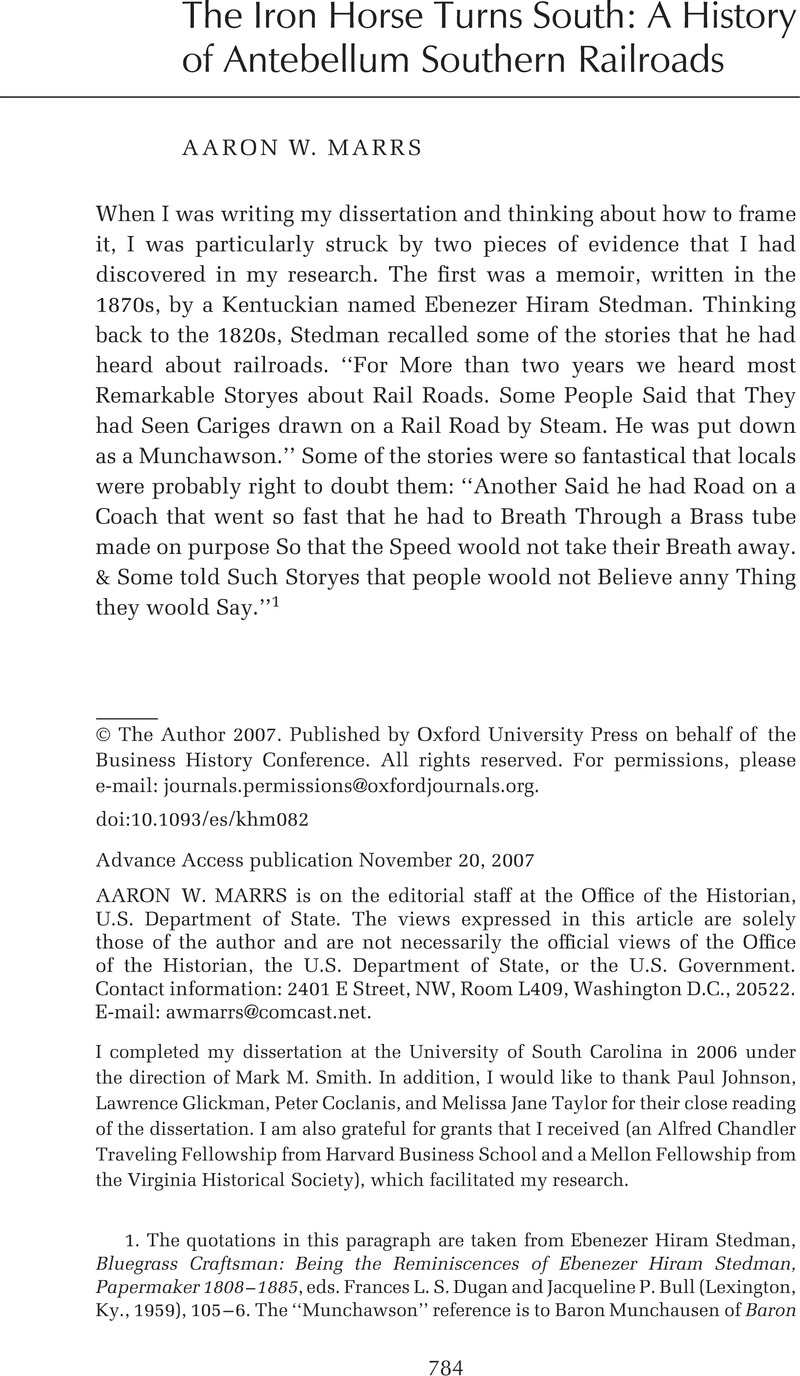No CrossRef data available.
Published online by Cambridge University Press: 18 February 2015

1. The quotations in this paragraph are taken from Stedman, Ebenezer Hiram Bluegrass Craftsman: Being the Reminiscences of Ebenezer Hiram Stedman, Papermaker 1808–1885, eds. Dugan, Frances L.S. and Bull, Jacqueline P. (Lexington, Ky., 1959), 105–6.Google Scholar The “Munchawson” reference is to Baron Munchausen of Baron Munchausen’s Travels (1785), a satirical collection of tall tales. See Carswell, John The Romantic Rogue: Being the Singular Life and Adventures of Rudolph Eric Raspe, Creator of Baron Munchausen (New York, 1950), 184–89.Google Scholar
2. Chadwick, Thomas W. ed., “The Diary of Samuel Edward Burges, 1860–1862,” South Carolina Historical and Genealogical Magazine 48 (April 1947): 66,Google Scholar 67, 73. “T.O.” is an abbreviation for “turnout,” or siding.
3. For an overview of this debate, see Downey, Tom Planting a Capitalist South: Masters, Merchants, and Manufacturers in the Southern Interior, 1790–1860 (Baton Rouge, La., 2006), introduction.Google Scholar
4. Majewski, John and Tchakerian, Viken “Markets and Manufacturing: Industry and Agriculture in the Antebellum South and Midwest,” in Global Perspectives on Industrial Transformation in the American South, eds. Delfino, Susanna and Gillespie, Michele (Columbia, Mo., 2005), 134.Google Scholar See also Bateman, Fred and Weiss, Thomas A Deplorable Scarcity: The Failure of Industrialization in the Slave Economy (Chapel Hill, N.C., 1981).Google Scholar
5. Fox-Genovese, Elizabeth and Genovese, Eugene Fruits of Merchant Capital (New York, 1983), 59.Google Scholar See also Genovese, Eugene The Political Economy of Slavery, 2nd ed. (Middletown, Conn., 1989).Google Scholar
6. Marx, Leo The Machine in the Garden: Technology and the Pastoral Ideal in America, rev. ed. (New York, 2000), 27, 219.Google Scholar
7. Appleby, Joyce Inheriting the Revolution: The First Generation of Americans (Cambridge, Mass., 2000), 266.Google Scholar
8. Brown, Richard D. Modernization: The Transformation of American Life, 1600–1865 (New York, 1976), 181.Google Scholar
9. Johnson, Walter “The Pedestal and the Veil: Rethinking the Capitalism/Slavery Question,” Journal of the Early Republic 24 (summer 2004): 305.Google Scholar
10. Ward, James A. “On Time: Railroads and the Tempo of American Life,” Railroad History 151 (1984): 87–95;Google Scholar and Bartky, Ian R. Selling the True Time: Nineteenth-Century Timekeeping in America (Stanford, Calif., 2000).Google Scholar
11. Marx, Machine in the Garden, 205.